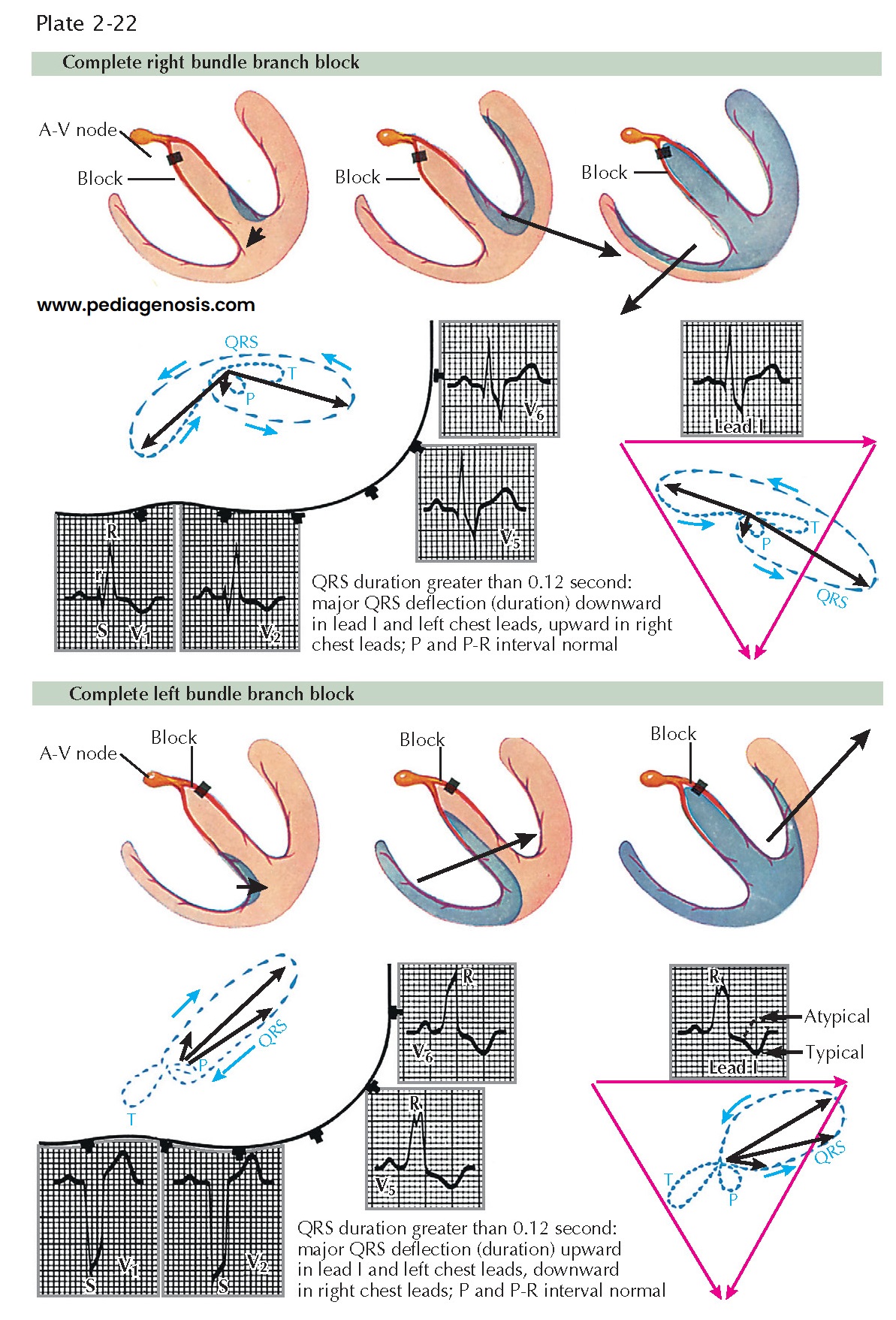BUNDLE
BRANCH BLOCK
The term bundle branch block (BBB) indicates disease in, or altered transmission through, certain branches of the conduction system of the heart. Blocks may occur in the left or right ventricle or in both. A characteristic change is widening of the QRS complex greater than 0.1 second. When the duration of this complex ranges from 0.1 to 0.12 second, the block is incomplete; if greater than 0.12 second, a complete BBB exists. With a complete right BBB the first 0.04 second of the QRS complex is normal in configuration, but the last portion is abnormal (see Plate 2-22). With a left BBB the total duration of the wave is written by an abnormal depo- larization wave, and the tracing is abnormal.
Bundle branch
blocks may be typical or atypical. A typical BBB has a lesion only in
the bundle of His or one of its branches, and there is no associated lesion. An
atypical BBB, in addition to the block, has some other lesion (e.g.,
MI). A typical block has T waves in the opposite direction as the wave of
greatest duration in the QRS complex (i.e., T is opposite S in right BBB in V6,
but T is opposite R in lead V1). An atypical block does not
necessarily follow this rule.
Only a small
defect in the right bundle of His is necessary to block the right bundle. The
first electric move- ment is normal from the left side of the septum to the
right; this writes the usual septal Q wave in leads V5 and V6.
The next movement is through the left ventricle from the endocardium to the
epicardium, and this writes a normal R wave in leads V5 and V6.
Finally, there is a slow progression of the activation wave through the septum
and the Purkinje system on the right and through the right ventricle, which
requires more time. As a result, there is a wide S wave in leads V5
and V6, and the duration of the S wave is usually greater than that
of the R wave in the QRS complex. This order of depolarization right, then
left, then right registers, in lead V1, an R, an S, and an R′ wave, and here the duration of the R′ wave is greater than that of the R wave. The VCG shows the electromotive
forces going first to the right, then to the left, and then back to the right again. Writing of the VCG slows down
(dots closer together) during late ventricular depolarization because the
activation of the right ventricle is slow. The horizontal-plane VCG is to the
right, then to the left, and then to the right front, whereas the frontal-plane
ACG is right, then left, then right, and often up. Recall that in a right BBB
the first part of the QRS loop is normal, but the last part is abnormal.
Right BBB often
is caused by arteriosclerosis or prolonged strain on the right ventricle, as in
pulmonary hypertension or pulmonary stenosis.
LEFT BUNDLE
BRANCH BLOCK
A block in the left bundle of His alters the entire ventricular-depolarization pathway. Ventricular depo- larization starts from the right side of the septum and progresses toward the left front, writing small R waves in leads V1 and V2. The voltage next swings toward the left near the cardiac apex, then toward the left base, writing tall R waves in leads I, V5, and V6 and S waves in leads V1 and V2. The electric movement is generally toward the left scapula, and characteristically the S-T segments and T waves are opposite in direction to the major deflection of the QRS complex. When this QRS complex–T wave relationship occurs, the tracing is characteristic of typical left BBB. When the QRS complex and the T wave are not opposite or are concordant, the tracing is referred to as atypical, and another lesion (e.g., MI) probably is present as well as the block. Left BBB is caused by arteriosclerosis, MI, cardiac failure, or severe strain on the left ventricle, as in hypertension.





